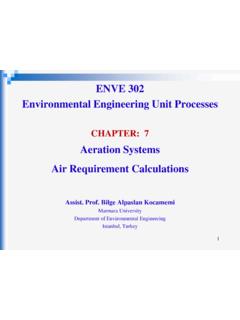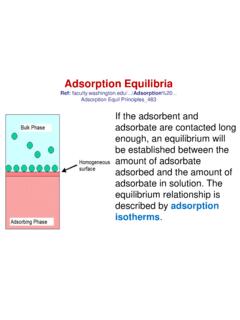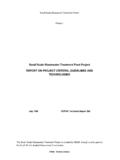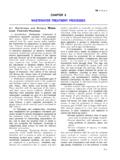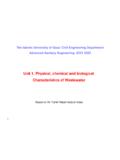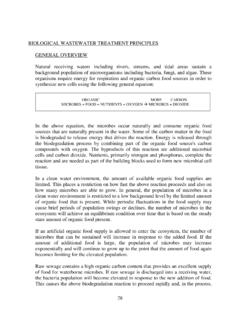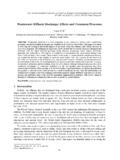Transcription of Principal wastewater constituents Treatment methods for ...
1 ENVE 302 Environmental Engineering Unit Processes Assist. Prof. Bilge Alpaslan Kocamemi Marmara University Department of Environmental Engineering Istanbul, Turkey CHAPTER: 1 Principal wastewater constituents Treatment methods for wastewater wastewater Industrial ww Municipal (domestic) ww Characteristics of industrial ww vary from industry to industry Industrial wastewater with characteristics compatible with municipal ww is often discharged to municipal sewers. However, many industrial ww require pre- Treatment to remove non-compatible substances prior to discharge into municipal system wastewater wastewater flow Lcd 750 460 240 Ref.
2 Metcalf & Eddy, 2004 Typical Composition of Domestic wastewater constituents of wastewater Physical Solids Turbidity Color Temperature Density Conductivity Chemical Inorganic Nutrients(N,P) Metals Gases pH Chloride Sulfur Alkalinity Organic Aggregate organic constituents (comprising a number of organic constituents with similar characteristics that can not be distinguished separately. Individual compounds VOCs, phenols, pesticides. Biological Microorganisms Pathogenic organisms Typical domestic ww 40-60% protein 25-50% carbonhydrate 8-12% oil-fat.)
3 Ref: Metcalf & Eddy, 2004 Classification of Solids Ref: Metcalf & Eddy, 2004 Measurement of Solids Characterization of Organic Content BOD (Biochemical Oxygen Demand) COD (Chemical Oxygen Demand) TOC (Total Organic Carbon) ThOD (Theoretical Oxygen Demand) UV absorbing organic constituents BOD (Biochemical Oxygen Demand) Measurement of the dissolved oxygen used by microorganisms in the biochemical oxidation of organic matter CBOD (carbonecous BOD): oxygen demand exerted by the oxidizable carbon in the sample NBOD (nitrogenous BOD): oxygen demand associated with the oxidation of ammonia to nitrate (nitrification) Ref: Metcalf & Eddy, 2004 cBOD & nBOD However; if a sufficient number of nitrifying bacteria is present initially interference of cBOD measurement caused by nitrifiers can be significant To supress nitrification.
4 Methylene blue ATU (Allythiourea) Reproductive rate of nitrifiers is slow it normally takes from 6-10 days for them to reach significant numbers to exert a measurable oxygen demand COD (Chemical Oxygen Demand) Measure the oxygen equivalent of the organic material in wastewater that can be oxidized chemically using dichromate in an acid solution 3422272cbandCr2cNHOH2c3d8anCOH)cd8(OdCrN OHC2c3b6a3n2dwhere organic substances which are difficult to oxidize biologically ( lignin) can be oxidized chemically.
5 Substances that are oxidized by dichromate ( sulfide,sulfite, ferrous ion) 3. Certain organic substances may be toxic to microorganisms used in the BOD test. Why not cBOD is equal to COD ? Typical BOD/COD of untreated domestic wastewater : If BOD/COD ratio is : Waste is considered to be easily treatable by biological means If BOD/COD ratio is : Organics in wastewater may be refractory Organics in wastewater are degradable. However, another substance in wastewater leads to inhibition of bacteria that uses organic matter Bacteria is not acclimated to wastewater TOC (Total Organic Carbon) Done instrumentally (5-10 min) to determine total organic carbon in aqueous sample (mg C/L) This test measures all C as CO2 Inorganic C (CO2, HCO3)
6 Present in wastewater must be removed prior to analysis by acidification and aeration of sample prior to analysis Typical BOD/TOC of untreated domestic wastewater O2/mg C ThOD (Theoretical Oxygen Demand) ThOD of a wastewater is calculated as the oxygen required to oxidize the organics to end products Example : glycine CH2(NH2)COOH CH2(NH2)COOH + 3/2 O2 NH3 + 2 CO2 + H2O For nitrogenous oxygen demand : NH3 + 3/2 O2 HNO2 + H2O HNO2 + 1/2 O2 HNO3 + H2O ThOD = (3/2 + 3/2 + 1/2) mol O2 / mol glycine UV Absorbing constituents Humic substances Lignin Strongly absorb UV Tannin Various aromatic compounds UV absorption has been used as a surrogate measure for the organic compounds cited above UV wavelength = 200 400 nm (254 nm most common) rbsCOD (soluble) : quickly assimilated by biomass sbCOD (particulate).
7 Must be firts dissolved by extracellular enzymes assimilated much slower rate nbVSS nonbiodegredable particulate (nbpCOD): since it is organic material, it will also contribute VSS. Influent wastewater will also contain non-voltile suspended solids that add to the MLSS concentration Inert TSS (iTSS) iTSS=TSSinf VSSeff Ref: Metcalf & Eddy, 2004 COD Fractionation Determination of soluble COD Filtration through m membrane analysis of the for COD Determination of bCOD BOD test data is necessary bCOD consumed in BOD test = oxygen consumed (uBOD) + oxygen equivalent of remaining cell debris bCOD = uBOD + fd Yh bCOD Yield coeff.
8 G VSS/g COD used Fraction of cell mass remainig as cell debris (g/g) bCOD/BOD= (uBOD/BOD) / ( fd Yh) For typical domestic ww: fd= , Yh= , uBOD/BOD= bCOD/BOD= Not all of the bCOD is oxidized in the BOD test Some of the bCOD is converted into biomass uBOD < bCOD Determination of rbCOD Biological Response Test for rbCOD Pre-aerated wastewater mixed with acclimated sludge DO concentrations with respect to time is measured Slope of DO vs time graph (mg/L DO) / time = OUR (Oxygen Uptake Rate) When DO decreases to about 3mg/L , vigorous aeration is applied to elevate DO conc.
9 To 5 to 6 mg/L. So another OUR measurement can begin WWWWASCOD,HAVVVY1 OrbCODVAS=volume of activated sludge used in the test (mL) Vww=volume of ww (mL) OA=oxygen consumed in area A (mg/L) YH,COD=synthesis yield coeff for heterotrophic becteria (g cell COD/g COD used) Biological Response Test for rbCOD (continue) b) Physical seperation technique for rbCOD (Mammais et al, 1993) may not give the exact results as the rbCOD concentration determination by respirometry, but it provides a reasonable estimate used widely because of its simplicity The procedure is based on the assumption that suspended solids and colloidal material can be captured effectively and removed by flocculation with a zinc hydroxide precipitate to leave only truly dissolved organic material after filtration Procedure.
10 1 ml of a 100 g/L ZnSO4 solution is added to 100 ml of sample with vigorous mixing for 1 min The pH is raised to about using 6 M NaOH with 5-10 min of gentle mixing for floc formation The sample is settled for 10-20 min and the supernatant is withdrawn and filtered using a m membrane filter The filtrate is analyzed for COD conc. rbCOD rbCOD = CODww COD act. sludge treated sample Physical seperation technique for rbCOD (continue) sCOD= soluble COD sBOD= soluble BOD Filtration through m membrane filter Non biodegradable VSS VSSpCODbpCOD1nbVSSsCODCODsBODBODBODbCODp CODbpCODS ummary COD= bCOD+nbCOD bCOD= BOD (for domestic wastewater ) nbCOD= sCODe+nbpCOD bCOD= sbCOD+rbCOD Nitrogen Forms in wastewater Ammonia (NH3) Ammonium (NH4) Nitrite (NO2-) Nitrate (NO3-)

